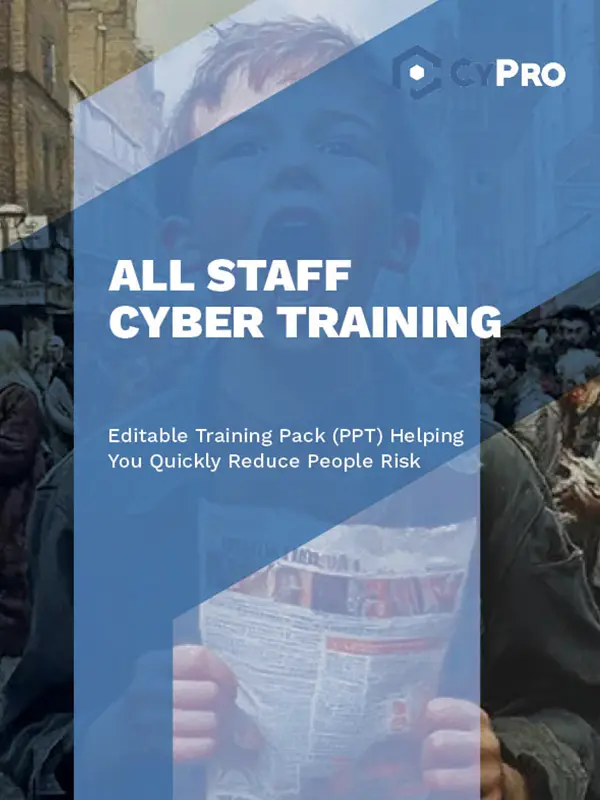Table of Contents
🧨 Security Debt: The Quiet Liability SMBs Carry
Like technical debt, cyber security debt accumulates when small to medium-sized businesses (SMBs) prioritise speed over structure. But along the way, there’s always that voice saying, “We’ll deal with that later.” When it comes to cyber security, “later” often turns into “never” until something goes wrong.
Security debt, like technical debt, builds up behind the scenes when controls are skipped, policies are delayed, or tools are bolted on without oversight. The difference? Security debt doesn’t just slow you down; it leaves you vulnerable.
Weak passwords, unmanaged user access, a lack of incident response plans, or unknown third-party app usage all contribute to a growing, often invisible liability.
The worst part? Most SMBs don’t realise how much security debt they’ve accumulated until it’s surfaced by a breach, a major sales deal, or an investor due diligence process.
There are only two types of companies: those that have been hacked and those that will be.” – Robert Mueller, former FBI Director.
💸 The Hidden Costs of Inaction

Cyber security debt doesn’t show up on your balance sheet, but it impacts almost every part of the business:
- Lost revenue from delayed contracts or failed procurement due to a weak security posture
- Reduced valuation when investors discover a lack of controls or breach readiness
- Regulatory fines or legal action from a mishandled incident
- Reputational damage occurs when customers lose trust due to a breach or data mishandling
According to IBM’s 2023 Cost of a Data Breach Report, the average breach cost for companies with fewer than 500 employees was $3.31 million. That’s not a rounding error; it’s a business-ending event for many SMBs. Even a minor phishing attack can still result in notification costs, reputational fallout, and hours of firefighting. Those hours turn into days if you don’t have plans, logs, or clarity.
Delaying security investments doesn’t preserve capital; it accumulates invisible risk that can cost far more in revenue, reputation and regulatory fallout.
🔍 Where Security Debt Hides in Plain Sight

Security debt forms in areas that are often invisible to fast-moving teams:
- Product: Secure coding guidelines are informal and inconsistent, vulnerability scanning is ad hoc (if done at all), and excessive permissions
- People: Phishing and social engineering training exist, but lack depth or frequency. There is no process for leavers and credentials are reused.
- Operations: Security policies may exist, but they’re outdated, siloed, or not embedded into day-to-day processes
- Tech stack: Unchecked Software as a Service (SaaS) sprawl, insecure integrations, unmanaged admin rights
These weaknesses often create unintentional gaps in your security measures, making it easier for cyber attacks to succeed.
It is not a matter of negligence; it is a matter of priorities. If left unchecked, those small gaps accumulate and become significantly more challenging to untangle as you scale.
🛠️ Paying Down Your Technical Debt, Without Losing Momentum
The good news is that you don’t need to pause growth to begin maturing your security. The solution is to treat it like any other tech debt: prioritise it, break it into stages and bring in the appropriate support.
Every SMB eventually hits the same wall: a mounting backlog of old systems, insecure platforms, or half-owned tools that no one wants to touch, but everyone knows are risky. These aren’t just technical loose ends – they’re liabilities. And they only get harder to fix over time.


That’s why we use the ✨Remediation Factory✨.
Rather than firefighting one issue at a time, the Remediation Factory introduces a repeatable process to reduce risk at scale. It’s a framework that treats security and technical debt not as isolated incidents, but as an ongoing, manageable workload, like a production line for clean-up and control.
❓ Why SMBs Need a “Remediation Factory“

Without a structured approach, legacy remediation often falls into one of three traps:
- The “break-fix” cycle – reacting to issues only after they cause disruption, without solving the root causes.
- Decision paralysis – endless debates about what to fix, when and how, especially with politically sensitive or shared systems.
- Inconsistency – reinventing the process every time, leading to bottlenecks, missed risks, or wasted effort.
The Remediation Factory model tackles all three by setting clear rules, expectations, and accountability.
⚙️ How the Remediation Factory Works
At its core, it is a programme-style workflow, with roles, phases and predefined outcomes. Here’s a high-level view of how it operates:
1. Scoping
- Identify systems with known risks (e.g. unsupported OS, open vulnerabilities).
- Use a simple scoring or points-based system to prioritise what qualifies as “high debt.”
2. Profiling (Triage)
- Collect key metadata: where the system sits (cloud/on-prem), who owns it, usage level, etc.
- Decide what’s in-scope (you can control it) vs out-of-scope (e.g. third-party owned).
3. Risk Assessment
- Use a defined rubric to score each system by exposure, criticality and vulnerability.
- Categorise risks: Critical, High, Medium, or Low.
- Flag items for indirect treatment where needed:
- Accept the risk formally
- Decommission the system
- Repurpose existing controls

4. Risk Treatment
- Map each risk level to a standard response. For example:
- Critical: Full remediation or shutdown
- Medium: Patch, restrict access, or monitor
- Low: Document and track
- Tailor responses based on platform type (e.g. on-prem vs cloud) and business context.
5. Execution
- Implement the chosen treatment:
- Mitigate: Patch, verify, and rescan
- Decommission: Follow a defined shutdown playbook
- Accept Risk: Get documented, accountable sign-off
- Each path has a sub-process, like modular parts of a production system
📌 The Principles That Make It Work
- Repeatability: It’s designed to run continuously, not as a one-off clean-up project.
- Efficiency over perfection: It prioritises action and momentum, even if every decision isn’t airtight.
- Governance that scales: Clear decision trees, standard roles, and workflows ensure progress even as complexity grows.
- Visual clarity: Using flow diagrams (e.g. Lucidchart) improves buy-in and helps stakeholders see the path forward.
Why It Matters?
Technical debt is a known problem. However, legacy security debt is more complex to quantify for many founders and tech leaders and even more challenging to fix, especially when teams are small and stretched. Gartner emphasises that unmanaged technical debt can impede system performance and scalability, leading to increased business costs and risks.
The Remediation Factory changes that. It creates momentum, not just awareness. It lets you first fix the most significant problems, document what cannot be done yet and prove progress to stakeholders.
Security isn’t just about avoiding risk; it’s about unlocking scale. A structured, scalable clean-up model like this can help you get there faster.
The Remediation Factory model isn’t one-size-fits-all, but if you’re curious about how it might apply to your business, get in touch. We’d be happy to explore it with you.
If you’re still tackling legacy risk case-by-case, you’re falling behind. The Remediation Factory gives you a system to do it faster, more intelligently and with less friction.
After a UK telecoms provider was acquired by private equity, it needed to unify five companies with fragmented systems and inconsistent security practices, all while meeting ISO 27001, Cyber Essentials Plus, and Telecommunications Security Act requirements. CyPro led the charge, providing a Virtual CISO, sector-specific architect and compliance lead to run a full maturity review, align controls and prepare for certification. In under four months, the business was fully certified, operating on a unified security framework and had clear risk visibility, giving leadership the clarity and assurance to scale confidently.
🚫 The Cost of Doing Nothing vs the Cost of Doing It Right

It’s easy to postpone security improvements when there’s no immediate crisis. But the cost of inaction builds quietly, and when it surfaces, it often does so at the worst possible time.
In practice, the true impact can be far greater:
- Security incident = tens of thousands in legal, technical, and PR fallout
- Delayed client deal = lost revenue and reputation
- Failed investor audit = stalled funding or down valuation
It’s not just theory; the numbers tell a clear story.
Think of security debt like interest on a loan: the longer you leave it, the more it compounds. Many small and mid-sized businesses could remediate their known security gaps, including system updates, staff training, and basic tooling, for around £20,000. That’s a realistic investment based on common needs like multi-factor authentication, endpoint protection, and expert guidance.
Now compare that to the cost of doing nothing. A single breach or ransomware incident can cost £90,000 to £180,000, once you factor in downtime, legal fees, lost clients, regulatory penalties, and recovery efforts. These aren’t hypothetical numbers; they come from real cases involving UK businesses of similar size.
Sources: UK Cyber Security Breaches Survey 2024, Hiscox Cyber Readiness Report 2023.
Fixing security debt is not just cheaper than a breach, it’s also a powerful signal to clients, partners and investors that you’re serious about protecting your business. In financial terms, spending a little now could save you six figures later. In strategic terms, it’s one of the smartest moves a growing business can make.
In 2023, UK logistics firm KNP Group collapsed after a ransomware attack exploited a weak employee password. Despite being a large company with cyber insurance, the breach wiped out key records and forced them into administration. KNP wasn’t an SMB, but the mistake was one any business could make. The impact could be fatal even faster for smaller firms with fewer buffers.
In contrast, Remediation Factory costs are predictable and can be scaled to match your size and needs. You get enterprise-grade support without hiring overhead and start building the internal security culture that large clients and investors look for.
And over time, you save more than money: you build credibility, resilience and trust.
📈 Making It Part of Your Growth Plan
Security maturity isn’t just about checklists and certifications. It’s a strategic enabler; one that helps you move faster, win bigger deals and grow confidently.
Here’s how:
- Map your security debt across teams, tools and workflows
- Align remediation with business milestones, e.g., Series A, enterprise deals, hiring expansion
- Report security progress to stakeholders in the same way you report product or sales traction
Done well, a Remediation Factory becomes a part of your operating rhythm. It grows with you, flexes to your needs and gives you the credibility to pursue bigger opportunities without taking on unnecessary risk.
The objective isn’t perfection; it’s about building strategic momentum. Partnering with a CSaaS provider to setup and establish a Remediation Factory, like CyPro, allows you to monitor monthly progress and showcase your growth when it matters most.

🫵 Final Word: Your Security Debt Won’t Pay Itself
Every business picks up a bit of security debt along the way. That’s normal. The question is whether you’re managing it or ignoring it.
The good news? You don’t need to solve everything overnight. You need a plan and the right people to help shape it.
At CyPro, we work with SMBs and scale-ups to bring structure, clarity, and momentum to precisely these challenges, whether building a security roadmap, preparing for certifications, or tackling that list of legacy systems no one wants to touch.
If you’re in this territory, you’re not alone. We’re here when you’re ready to explore what smart next steps might look like.











